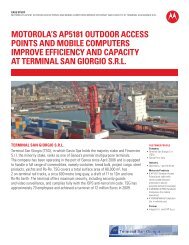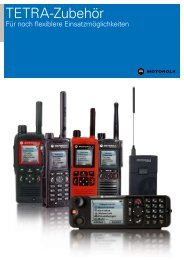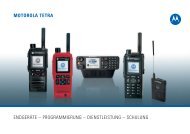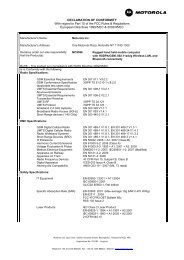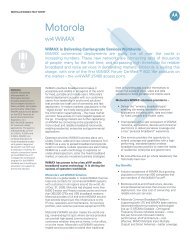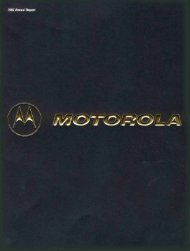Motorola annual report 1969 - Motorola Solutions
Motorola annual report 1969 - Motorola Solutions
Motorola annual report 1969 - Motorola Solutions
You also want an ePaper? Increase the reach of your titles
YUMPU automatically turns print PDFs into web optimized ePapers that Google loves.
<strong>Motorola</strong> <strong>annual</strong> <strong>report</strong> <strong>1969</strong>
financial<br />
highlights<br />
<strong>1969</strong> 1968<br />
(dollar amounts in thousands except per share data)<br />
Sales and other revenues $ 873,224 $ 775,124<br />
Income before taxes<br />
% to Sales<br />
Federal income taxes<br />
Earnings<br />
Per share of capital stock<br />
Capital expenditures<br />
Depreciation<br />
Working capital<br />
Current ratio<br />
Shareholders' equity<br />
Average shares outstanding<br />
Book value per share<br />
71,843<br />
8.23%<br />
38,050<br />
33,793<br />
5.48<br />
43,294<br />
22,531<br />
235,377<br />
2.47<br />
326,134<br />
6,164,084<br />
49.03<br />
57,376<br />
7.40%<br />
29,115<br />
28,261<br />
4.61<br />
32,009<br />
20,071<br />
176,315<br />
2.08<br />
238,778<br />
6,133,470<br />
38.84<br />
Yearend employment 45,000 41,000<br />
Cover: The newest approach to computer<br />
memory storage is exemplified by the 8192<br />
bit memory array. These modules are<br />
made possible by combining metal oxide<br />
semiconductors, beam lead bonding and<br />
computer-aided design and testing.
Creativity<br />
and Diversification<br />
in Electronics
contents<br />
financial highlights 1<br />
about the cover 1<br />
letter to shareholders 4<br />
semiconductor products division 6<br />
communications division 10<br />
consumer products division 14<br />
government electronics division 18<br />
automotive products division 20<br />
control systems division 22<br />
corporate marketing units 22<br />
balance sheet 24<br />
statement of earnings 26<br />
additional paid-in capital 26<br />
source and use of funds 27<br />
notes to financial statements 28<br />
ten year financial summary 29<br />
major facilities 30<br />
major product lines 30<br />
<strong>annual</strong> meeting 31<br />
directors and officers 32
to our<br />
shareholders<br />
and friends<br />
Sales and earnings reached new<br />
records in <strong>1969</strong>. Total revenues<br />
increased almost $100 million or<br />
13% to $873,224,220, while earnings<br />
increased 19% to $33,792,573 or<br />
$5.48 per share, compared to $4.61<br />
per share in 1968. These earnings<br />
remained after provision for over<br />
$58 million for federal, state and<br />
local taxes on income, property and<br />
payrolls.<br />
Our improving diversification in the<br />
growing electronics industry is<br />
benefiting us. Among the notable<br />
operating achievements of our<br />
various businesses in <strong>1969</strong> are the<br />
following:<br />
The semiconductor division<br />
emerged for the first time as the<br />
largest single segment of our<br />
business in terms of sales volume<br />
and earnings. Sales of this<br />
division increased in excess of<br />
35%, and earnings by an even<br />
higher rate over 1968.<br />
The communications division<br />
continued as our second largest<br />
business, posting a sales increase<br />
of about 13%.<br />
The consumer products division<br />
increased its share of market in<br />
every product line in the face of<br />
softening market conditions<br />
throughout the industry.<br />
The government electronics<br />
division improved earnings and<br />
margins despite slightly reduced<br />
billings and major reorganization<br />
of its plant facilities.<br />
The automotive products division<br />
established its first wholly owned<br />
overseas manufacturing operation—in<br />
England.<br />
The control systems division<br />
achieved another substantial<br />
increase in sales and obtained a<br />
contract for the country's largest<br />
installation of intrinsically safe<br />
electronic process control<br />
instrumentation.<br />
Research and Development<br />
A wide variety of research and<br />
product engineering and development<br />
programs was actively pursued<br />
in <strong>1969</strong>. Total expenditures for<br />
these purposes increased 24% in<br />
<strong>1969</strong> and are planned for another<br />
increase of about 20% in 1970.<br />
Corporate Marketing Units<br />
To further strengthen the company's<br />
position in several growth fields,<br />
three corporate marketing units<br />
were formed in <strong>1969</strong>. One group<br />
will seek to identify electronic systems<br />
opportunities which will use<br />
existing products and capabilities<br />
of any and all of our divisions.<br />
Another group will be responsible<br />
for marketing of electronic video<br />
recording (EVR) players. The third<br />
group will market products and<br />
systems for administration, operational<br />
control, communications and<br />
entertainment directly to institutional<br />
customers, such as hospitals,<br />
hotels and schools.<br />
Capital Expenditures<br />
Capital expenditures in <strong>1969</strong> totaled<br />
$43 million, more than half«of which<br />
was incurred by the semiconductor<br />
division in expanding and further<br />
equipping the integrated circuits<br />
facility at Mesa, Arizona and the<br />
Toulouse plant in France. A major<br />
portion was also incurred by the<br />
communications division in expanding<br />
plants in Schaumburg, Illinois<br />
and Fort Lauderdale, Florida.<br />
Capital expenditures for 1970 may<br />
exceed $55 million. Depreciation in<br />
<strong>1969</strong> was $23 million and will<br />
approximate $25 million in 1970.
Financing<br />
In November, rights were issued to<br />
shareholders to purchase 1 additional<br />
share of common stock of the<br />
company for each 13 shares held at<br />
a price about 19% below the market<br />
price at that time. Since all of the<br />
proceeds were used to repay h ghcost<br />
debt obligations, earnings of<br />
the company were not diluted<br />
because of the additional 474,952<br />
shares issued. At the same time, the<br />
net worth of the company was<br />
increased by the proceeds of<br />
approximately $58 million which,<br />
together with earnings retained,<br />
resulted in an improvement in the<br />
company's yearend ratio of debt<br />
(short and long term) to equity to<br />
30% from 56% at the end of 1968,<br />
thus providing a strong foundation<br />
for continued growth. The only<br />
remaining current bank debt is attributable<br />
to our foreign operations.<br />
Share Distribution and Dividends<br />
In February 1970, the board of<br />
directors adopted a proposal to be<br />
made to shareholders at the May 4<br />
<strong>annual</strong> meeting calling for an<br />
increase of authorized shares from<br />
10,000,000 to 20,000,000. Subject<br />
to shareholders' approval, the<br />
company plans to make a share-forshare<br />
distribution on May 25 to<br />
shareholders of record May 11.<br />
Also, the directors expressed the<br />
intention of raising the quarterly<br />
dividend to 15 cents per share in<br />
June for shares then outstanding.<br />
This would be equivalent to a 20%<br />
increase in the present <strong>annual</strong><br />
dividend rate.<br />
Management Changes<br />
Arthur L. Reese, director and<br />
formerly executive vice president,<br />
became a staff executive and continues<br />
as a director. He has long<br />
served the company importantly as<br />
general manager of the communications<br />
division and most recently<br />
as general manager of the consumer<br />
products division. He is<br />
succeeded in the latter capacity by<br />
Edward P. Reavey, Jr., formerly<br />
vice president for marketing of<br />
that division.<br />
At the corporate level, William J.<br />
Weisz, was elected executive vice<br />
president and assistant chief<br />
operating officer. He had been<br />
general manager of the communications<br />
division. Thomas J.<br />
Connors, formerly vice president<br />
and director of marketing for the<br />
semiconductor division, was named<br />
vice president of marketing for the<br />
corporation and later given the<br />
additional assignment as general<br />
manager of the control systems<br />
division.<br />
In the communications division,<br />
Homer L. Marrs was designated<br />
vice president and general manager.<br />
He had been vice president and<br />
director of distribution. John F.<br />
Mitchell, vice president, was named<br />
assistant general manager. Martin<br />
Cooper and Carl E. Lindholm were<br />
each elected vice presidents and<br />
directors of product operations.<br />
In the semiconductor division, John<br />
R. Welty, vice president, was designated<br />
assistant general manager<br />
and Christian G. Goodman was<br />
elected vice president and director<br />
of marketing for the division; John<br />
C. Haenichen and Patrick J. Lynch<br />
were elected vice presidents and<br />
directors of operations.<br />
Outlook<br />
As <strong>1969</strong> ended, the concerted efforts<br />
of federal authorities to suppress<br />
inflation were adversely affecting<br />
certain parts of our business and<br />
resulting in a moderation of the<br />
growth rate in others. A cost/price<br />
squeeze is a natural concomitant.<br />
Our assumptions for planning<br />
purposes regarding the general<br />
economy include the probability<br />
that monetary policy will be eased<br />
gradually during this year and that a<br />
more normal growth rate will<br />
thereafter resume.<br />
It is well known that softness has<br />
developed in the automotive and<br />
consumer hardgoods markets and<br />
there is a slowdown in certain<br />
federal government funding. These<br />
factors are, of course, having impact<br />
on the related segments of our<br />
business, particularly in the first and<br />
second quarters. However, the<br />
communications equipment and<br />
semiconductor markets have not<br />
been affected in the same degree.<br />
We are concentrating on improving<br />
productivity to offset the cost/price<br />
squeeze.<br />
On balance within this mixed<br />
environment, we currently can see<br />
the possibility of further increases<br />
in total revenues and earnings for<br />
1970 as a whole but this will depend<br />
on reduced pressure on the<br />
economy during the last half of<br />
the year.<br />
For the Board of Directors,<br />
CHAIRMAN OF THE BOARD<br />
PRESIDENT<br />
March 26,1970
semiconductor<br />
products<br />
division<br />
While the semiconductor industry grew<br />
by approximately 16 per cent during<br />
<strong>1969</strong>, <strong>Motorola</strong>'s semiconductor products<br />
division sales again grew by more<br />
than 35 per cent. Earnings increased<br />
over 1968 at a substantially greater rate.<br />
In the international marketplace, the<br />
gap between <strong>Motorola</strong> and the industry<br />
was even wider. While the industry grew<br />
by about 20 per cent in both Europe<br />
and the Far East, the division scored a<br />
sales increase of more than 60 per cent.<br />
During <strong>1969</strong>, as in the past, the division<br />
continued to place heavy emphasis on<br />
both increasing worldwide production<br />
capacity, and developing advanced,<br />
highly complex products for the next<br />
generation of electronic equipment.<br />
Early in the year, a small semiconductor<br />
operation was established in Tucson,<br />
Arizona, where production began early<br />
in 1970. At the integrated circuits<br />
center in Mesa, Arizona, 134,600 square<br />
feet of production area was added during<br />
<strong>1969</strong>, and another 82,200 square feet is<br />
still under construction at the site.<br />
Foreign production capacity was greatly<br />
increased during <strong>1969</strong>. Semiconductor<br />
production facilities, totaling 71,000<br />
square feet, were completed in Nogales<br />
and Guadalajara, Mexico, and East<br />
Kilbride, Scotland. The Nogales plant<br />
was brought into full production during<br />
the year. The Guadalajara and East<br />
Kilbride plants, presently in limited<br />
production, will be in full production<br />
early in 1970. In addition, the Seoul,<br />
Korea facility was expanded by 5,000<br />
square feet, and material processing<br />
capability was added to the Toulouse,<br />
France complex. A 30,000 square foot<br />
expansion was also begun at the<br />
Toulouse plant.<br />
While the market for discrete semiconductors<br />
maintained its healthy<br />
growth pattern during the year, emphasis<br />
in the marketplace continued to<br />
shift toward the more complex integrated<br />
circuit devices. During the year,<br />
the division again supplied the broadest<br />
line of integrated circuits in the industry,<br />
including not only the standard, high<br />
volume families, but also the even more<br />
sophisticated devices made possible by<br />
research and development in metal<br />
oxide semiconductors (MOS), computer-aided<br />
design (CAD), multi-layer<br />
metallization, dielectric isolation and<br />
beam lead bonding.<br />
In the digital integrated circuit market,<br />
significantly increased sales resulted<br />
from broadening product lines and utilizing<br />
advanced production techniques.<br />
Ninety-eight completely new digital integrated<br />
circuits were introduced, forty<br />
per cent more than in the previous year.<br />
A third of these introductions were in<br />
the increasingly popular transistortransistor<br />
logic (TTL) family. As a result,<br />
<strong>Motorola</strong> has become a major supplier<br />
of both industry-wide TTL circuit types<br />
and complex TTL functions. In addition,<br />
a third generation of emitter-coupled<br />
logic (ECL) circuits was introduced,<br />
establishing a new order of ultra-high<br />
speed performance for large computer<br />
systems, instrumentation and frequency<br />
synthesizers, areas which promise<br />
significant growth during the 1970s.<br />
The MECL-III family is the first digital<br />
integrated circuit series that provides<br />
subnanosecond (less than a billionth of<br />
a second) speeds. ..<br />
In linear integrated circuits, sales<br />
grew at twice the rate of the industry.<br />
Twenty-five devices were introduced,<br />
representing new "building blocks"<br />
for the systems designer and enabling<br />
manufacturers to produce better, less<br />
expensive and more efficient designs for<br />
instrumentation, computers, communications<br />
and entertainment products. By<br />
yearend, the division became one of<br />
the largest suppliers of linear integrated<br />
circuits in the industry.<br />
With linear circuits on the threshold of<br />
a dramatic growth period, plans are<br />
being readied to introduce more than 40<br />
new linear devices during the coming
year. Many of these products will feature<br />
new capabilities, such as high current,<br />
high voltage, thin-film compatibility, and<br />
radiation resistance.<br />
Semiconductor memories will play an<br />
important role in the next generation<br />
of computers. Along with individual<br />
monolithic integrated circuit memories<br />
containing smaller storage capacity, a<br />
series of highly complex, sub-system<br />
memory modules is also being developed.<br />
These new modules are being<br />
made possible through an advanced<br />
product manufacturing system which<br />
combines the MOS and beam lead technologies<br />
with computer-aided design<br />
and testing techniques. The first of these<br />
announced for introduction is an 8,192<br />
bit random access read-write memory<br />
(shown on front cover), larger and faster<br />
than any memory module presently<br />
available. Five more complex modules<br />
1. Computer-aided design of<br />
integrated circuits reduces design<br />
and production time for custom<br />
and LSI circuits.<br />
2,4. Beam lead bonding solves<br />
many critical and time consuming<br />
bonding operations.<br />
3. Functional circuits (small<br />
scale integration) and advanced<br />
plastic encapsulated devices open<br />
large segments of consumer market<br />
by lowering production costs.<br />
5. Computer-operated step<br />
and repeat camera, with precision<br />
of 0.0001 inch, photographically<br />
reduces integrated circuit designs<br />
for mask production.
will be introduced during the first<br />
quarter of 1970.<br />
The coupling of advanced product<br />
technologies with well-known volume<br />
production flexibility is resulting in the<br />
development of a variety of state-ofthe-art<br />
devices.<br />
Multilayer metallization, which increases<br />
yields by reducing the die size on the<br />
wafer, made possible a 14-bit time<br />
division demultiplexer built on a single<br />
chip. This circuit is being used in the<br />
Boeing 747. In addition to a number of<br />
standard circuits, 25-gate and 112-gate<br />
TTL arrays were also produced with this<br />
technique.<br />
The latest beam lead bonding methods,<br />
which increase reliability and performance,<br />
are being used to mass produce<br />
TTL circuits and linear circuit chips.<br />
This technique produces circuits of an<br />
extremely high order of reliability, as<br />
required by the government and aerospace<br />
markets.<br />
Dielectric isolation processes are being<br />
used in devices requiring radiation<br />
resistance. Beside their superior performance<br />
in radiation environments,<br />
these devices will find broader applications<br />
in other new markets which<br />
require high voltage and high current<br />
capability. The division has already<br />
achieved a leadership role in this young<br />
but promising technology.<br />
The computer is being used as a vital<br />
tool in the design of complex circuits.<br />
Computer-aided design (CAD) helps the<br />
designer in specifying product and<br />
analyzing proposed circuits through<br />
logic simulation, circuit analysis and<br />
the determination of component and<br />
interconnect placement. After the design<br />
is complete, the computer controls the<br />
drafting function, and generates test<br />
programs. CAD is playing an important<br />
role in the development of MOS<br />
capability, since most MOS devices<br />
require custom design. Using this<br />
advanced design technique, the division<br />
expects further penetration in this expanding<br />
market during the coming year.<br />
Discrete devices during <strong>1969</strong> accounted<br />
for more than 65 per cent of the dollar<br />
volume of the total semiconductor<br />
industry. In this high volume market,<br />
divisional sales continued to strengthen.<br />
<strong>Motorola</strong>'s leadership in the discrete field<br />
results in part from continuing research,<br />
production refinements, and the introduction<br />
of a constant stream of new<br />
products. The development of new markets<br />
in the appliance field for zener<br />
diodes, silicon signal transistors and<br />
silicon power transistors is also adding<br />
impetus to this growth, as is the rapidly<br />
growing demand for plastic encapsulated<br />
devices in the entertainment market.<br />
Optoelectronics is an example of the<br />
division's continuing investment in<br />
discrete devices. A major industry<br />
breakthrough in materials processing<br />
during <strong>1969</strong> permitted the introduction<br />
of visible red light emitting devices<br />
which can be used as indicator lights,<br />
in numeric readouts and card readers,<br />
opening a potentially huge market. Next<br />
year will see the introduction of a<br />
number of additional optoelectronic<br />
components and a complete alphanumeric<br />
readout using light emitters.<br />
In <strong>1969</strong> <strong>Motorola</strong> also introduced<br />
discrete "functional circuits," which, in<br />
complexity, lie between discrete devices<br />
and integrated circuits. Containing a<br />
limited number of transistors and<br />
passive components, these devices<br />
create a variety of inexpensive partial<br />
circuits for the mammoth consumer<br />
products industry. These circuits cost<br />
less than the equivalent discrete components,<br />
and are built, packaged and<br />
tested as easily as a single component.<br />
Seven "functional circuits" were introduced<br />
during the year and ten more are<br />
scheduled for 1970.<br />
The continual probing at the limits of<br />
the semiconductor art, and the steady<br />
introduction of new and improved<br />
devices are helping to insure a major<br />
role for <strong>Motorola</strong> in tomorrow's semiconductor<br />
market, which promises a<br />
steady growth in size, complexity and<br />
competitiveness.<br />
The semiconductor market will continue<br />
to grow during 1970 although at a<br />
slower rate than in <strong>1969</strong>. While discrete<br />
component sales for the industry are<br />
expected to level during the year, the<br />
division again anticipates both<br />
increased sales and share of market.<br />
Integrated circuits will continue to<br />
account for a greater share of the total<br />
semiconductor business, increasing by<br />
about 25 per cent over <strong>1969</strong> in total<br />
factory sales. It is expected that<br />
<strong>Motorola</strong>'s growth in this market will<br />
outpace the industry.<br />
In spite of the cooling economy, several<br />
semiconductor markets have the potential<br />
for significant growth this year<br />
through increased penetration. These<br />
include the military-aerospace, consumer,<br />
computer and industrial markets.
1. Electrical probes test individual<br />
light emitting diode on wafer.<br />
* r ~<br />
2. Computer controlled probes<br />
perform electrical inspections of<br />
individual, dielectrically isolated<br />
integrated circuits while still on<br />
silicon wafer.<br />
3. Multi-layer metallization<br />
process increases yield by reducing<br />
die size, thus aiding custom circuit<br />
design and production of LSI circuits.<br />
,2
communications<br />
division<br />
The year <strong>1969</strong> completed a decade of<br />
steady growth for the division's communications<br />
systems, which include<br />
mobile, portable, industrial systems and<br />
component product groupings. Technological<br />
advances, market expansion<br />
and customer confidence in <strong>Motorola</strong><br />
products has kept the division in its<br />
leading position.<br />
Sales volume during the year reached a<br />
new high with increases in all product<br />
activities. New order input ran well<br />
ahead of plan and resulted in a substantial<br />
increase in open order backlog<br />
compared to the same time last year.<br />
Earnings also set new highs and outpaced<br />
sales growth during the year.<br />
Improved profits, despite continued<br />
increases in costs, resulted from the<br />
increased volume and significant<br />
improvements in operating efficiencies.<br />
Domestically, the division carried on an<br />
extensive expansion program during the<br />
year. A new manufacturing facility was<br />
opened in Fort Lauderdale, Florida. To<br />
accommodate the rapid growth of<br />
operations there, a 250,000 square foot<br />
facility is now being planned to replace<br />
the leased site. At the Schaumburg,<br />
Illinois headquarters site, a 317,000<br />
square foot addition is being added to<br />
the present 750,000 square foot facility.<br />
A reorganization of international operations<br />
during <strong>1969</strong> placed new emphasis<br />
on the division's plans to broaden these<br />
operations dramatically during the<br />
1970's. Majority control of Canadian<br />
<strong>Motorola</strong> Electronics Ltd. was acquired,<br />
and a new wholly owned subsidiary<br />
became operational in Wiesbaden,<br />
Germany.<br />
The division now has worldwide distribution<br />
of products and services in 91<br />
countries. Included are seven subsidiaries<br />
or joint ventures in Brazil,<br />
Argentina, Mexico, Canada, Israel,<br />
South Africa and Germany. These seven<br />
manufacturing operations provide<br />
direct distribution in those countries.<br />
Research and development remains the<br />
foundation upon which the division<br />
retains its position in the industry. The<br />
development and manufacture of many<br />
component products for internal use<br />
has led to a natural progression into the<br />
business of supplying original equipment<br />
manufacturers. For example, a<br />
distinct line of crystal products has<br />
been developed. This family of components<br />
includes a series of precision<br />
quartz crystals, precision oscillators,<br />
temperature-controlled crystal oscillators,<br />
precision crystal filters and<br />
monolithic crystal filters. Extensive<br />
research is being conducted into the<br />
processing of synthetic quartz, from<br />
growing to final packaging. Also being<br />
supplied to customers are a series of<br />
reed devices, plug-in tone modules and<br />
printed circuit boards.<br />
Technical advances through fabrication<br />
of other components and the use of<br />
modern computer-aided design techniques<br />
allowed the division to develop<br />
many exceptionally improved product<br />
lines during <strong>1969</strong>. The quality, reliability<br />
and simplified maintenance designed<br />
into these new products have received<br />
acclaim from our customers.<br />
Foremost in design achievement was<br />
the development of a new line of handheld,<br />
two-way portable radios with a<br />
size reduction of 50 per cent ahd weight<br />
reduction of 40 per cent over the<br />
previous model line. A significant 250<br />
per cent increase in rf power output<br />
distinguishes the HT-220 "Handie-<br />
Talkie" portable radio as the smallest<br />
and lightest 5-watt unit in the industry.<br />
Division engineers designed two monolithic<br />
integrated circuits to replace 51<br />
previously used components to achieve<br />
the dramatic 50 per cent size reduction.<br />
The development of a smaller, lighter,<br />
rechargeable nickel-cadmium energy<br />
cell, in addition to the fewer component<br />
parts, enabled the 40 per cent weight<br />
reduction.<br />
10
1. Advanced design products<br />
and systems result from continuous<br />
research and development of<br />
microelectronic devices.<br />
2. Computer-aided design<br />
techniques allow simplification of<br />
design to achieve better reliability,<br />
easier maintenance and greater<br />
cost savings.<br />
3. Sales and market specialists<br />
provide technical expertise in the<br />
development of customized<br />
communication systems to solve<br />
customer problems.<br />
4. Simplified flow-type design<br />
reduces costs and makes solid<br />
state two-way radio economically<br />
feasible for all users.<br />
5. Portable two-way radio exemplifies<br />
monolithic integrated<br />
circuit developments and high<br />
density packaging techniques.<br />
11
Reaching further still into high density<br />
component design, the division developed<br />
a short range mini-unit that is 23<br />
per cent smaller and 28 per cent lighter<br />
than the previously described model<br />
line. Weighing only 15 ounces, the 17<br />
cubic inch HT-100 "Handie-Talkie"<br />
portable radio utilizes the latest in<br />
integrated circuitry. A single, doublesided<br />
circuit board was designed to fit<br />
around the speaker and holds all components<br />
of the separate transmitter<br />
and receiver sections.<br />
The second major design achievement<br />
was the development of a top performance,<br />
all solid state, mobile radio manufactured<br />
at a significant cost savings.<br />
Designated the "MOCOM 70" radio, the<br />
new unit features a simplified design for<br />
better reliability and easier maintenance.<br />
Using computer-aided design<br />
techniques, the receiver and transmitter<br />
circuitry was laid out in a flow type of<br />
design on a single layer circuit board.<br />
The elimination of other circuit boards<br />
and the resultant decrease of materials<br />
reduced costs and made solid state<br />
radio economically feasible for every<br />
type of two-way mobile radio user.<br />
Due to the increasing variety and<br />
number of customers, the division is<br />
placing greater emphasis on organizing<br />
specialized market/sales teams to<br />
better service customer groups. With<br />
over 400 types of customers, it becomes<br />
essential to have specialists who are<br />
familiar with specific businesses and<br />
related operational problems, and who<br />
are capable of developing solutions to<br />
these problems. These market teams, in<br />
alliance with their customers, provide<br />
the division with the technical expertise<br />
necessary to design new and better<br />
uses of communication systems.<br />
In <strong>1969</strong> over 50 new communication<br />
systems were introduced in response to<br />
the needs of the market. Some of these<br />
were: a disaster radio network for area<br />
hospitals; a 12-channel improved<br />
mobile telephone system with automatic<br />
channel selection and dial operation;<br />
base station control units and<br />
repeaters in the 450 MHz and 960 MHz<br />
bands; an all solid state 6 GHz rf microwave<br />
with full 600-channel capability<br />
and a 2 GHz version with 300-channel<br />
capability; a high capacity paging encoder<br />
expandable to 870 calls; an alarm<br />
<strong>report</strong>ing system for monitoring remote<br />
functions; radio switches capable of<br />
controlling up to 16 different remote<br />
functions; several closed circuit television<br />
accessories for automatic lens<br />
adjustment, high-temperature camera<br />
protection and automatic video sequential<br />
scanning of up to 10 cameras from<br />
a single monitor; and several special<br />
precision instruments such as the<br />
television frequency stabilizer system.<br />
Two-way radio is playing an increasingly<br />
large part in our everyday life.<br />
Today, many mobile radio users are<br />
faced with severe overcrowding due to<br />
the limited number of radio frequencies<br />
allocated. For many years, <strong>Motorola</strong> has<br />
led an aggressive technological effort<br />
to derive more use out of the available<br />
spectrum. This effort has increased the<br />
number of channels in the frequency<br />
spectrum by four to one. Now, the<br />
Federal Communications Commission is<br />
considering proposals to allocate more<br />
frequencies to two-way radio users and<br />
to permit them to share or use exclusively<br />
frequencies currently allocated<br />
to TV broadcasting. None of these proposals<br />
will significantly affect the television<br />
viewing public but will permit<br />
continued growth in the two-way radio,<br />
public-service oriented market area.<br />
In the 1970's, the division will continue<br />
to develop its technical capabilities and<br />
looks forward to even greater gains in<br />
strengthening its domestic and international<br />
position. The forecast for 1970<br />
is for continued increase in both sales<br />
and earnings. The current open order<br />
backlog and new market and product<br />
programs hold promise for new sales<br />
growth. Continued improvements in<br />
operating efficiencies coupled with the<br />
additional volume should again generate<br />
improved earnings.<br />
12
1.An additional 317,000<br />
square feet under construction at<br />
the Schaumburg, Illinois<br />
headquarters.<br />
2. Technological advances in<br />
visual communication products<br />
keep the division ahead of<br />
market needs.<br />
3. <strong>Motorola</strong>-trained technicians<br />
perform system maintenance<br />
on-site or at service centers<br />
throughout the country.<br />
4. Extensive research is being<br />
conducted in the processing of<br />
synthetic quartz for frequency<br />
oscillators and filters.<br />
13
consumer<br />
products<br />
division<br />
With a severe fall-off in consumer<br />
buying, particularly during the critical<br />
fourth quarter affecting the entire industry,<br />
forecasted sales and profit goals of<br />
the division were not achieved. However.,<br />
division performance during <strong>1969</strong><br />
resulted in market penetration gains in<br />
every product category as measured by<br />
Electronic Industries Association data.<br />
This gain in the face of a general<br />
industry decline reaffirms the validity of<br />
the division's broadened marketing<br />
philosophy and lays the foundation for<br />
improved performance in 1970.<br />
Quasar Color TV best exemplifies the<br />
division's strategy of concentrating<br />
marketing effort behind products with<br />
unique and demonstrable advantages.<br />
Supported by increased investment in<br />
research and development and greater<br />
utilization of the technical capabilities<br />
of other divisions, this strategy is being<br />
expanded into other product lines. Such<br />
products are introduced first into the<br />
upper price ranges. Once consumer<br />
demand has forged a solid sales base,<br />
models with similar advantages but at<br />
lower price points will be introduced,<br />
contributing to a growing market share.<br />
Exemplifying this "layering-on" concept<br />
of product introduction was the announcement<br />
of Quasar II — a second<br />
generation "works in a drawer" line.<br />
These lower priced consoles and table<br />
models were designed to compete in<br />
the color market's fastest growing segment.<br />
Development of Quasar portables<br />
advanced during the year to open<br />
additional 1970 marketing opportunities.<br />
The decision to eliminate the manufacture<br />
of tube type color TV in favor of<br />
a virtually all Quasar color TV line<br />
confirms <strong>Motorola</strong>'s substantial competitive<br />
lead in the application of solid<br />
state technology.<br />
Advertising concentrated on translating<br />
Quasar TV benefits into language that<br />
creates consumer buying. The phrase<br />
"works in a drawer" is now the best<br />
known feature in color TV according to<br />
independent research. The Quasar TV<br />
campaign was chosen by retailers as<br />
the year's best in a major trade magazine<br />
survey. Coordinated use of the<br />
"works in a drawer" concept in advertising,<br />
display, training and selling<br />
resulted in a substantial increase in the<br />
division's share of retail color TV sales<br />
over $600.<br />
In other product lines, technical development<br />
was aimed at new or growing<br />
markets. The division's first cassette<br />
tape players were introduced in midyear<br />
with successful results and further<br />
additions are planned. In December, the<br />
forerunner of a complete line of stereo<br />
components was announced to compete<br />
profitably in the fastest growing<br />
segment of stereo sales.<br />
The reliability and serviceability concept<br />
of Quasar color TV was brought into<br />
two important screen sizes of black and<br />
white TV through the application of<br />
replaceable solid state mini-circuits.<br />
Division efforts in automotive sound<br />
products were directed to the car tape<br />
player line and to FM/AM auto radios.<br />
The personal electronic product group<br />
neared completion of development work<br />
for a new and specialized series of<br />
radios and portable phonographs which<br />
will take maximum advantage of the<br />
semiconductor division's integrated<br />
circuit capability. This use of the latest<br />
state-of-the-art technology will help<br />
combat growing foreign product<br />
strength.<br />
14
STRATEGY<br />
Layer on<br />
small screen<br />
Increased<br />
Quasar<br />
share of<br />
market<br />
Layer on<br />
large screen<br />
portables<br />
Layer on m<br />
lower priced y<br />
consoles & table<br />
models<br />
Introduction:<br />
large screen<br />
consoles<br />
1967 1968 <strong>1969</strong> 1970 1971 1972<br />
Phase I — introduce and develop market<br />
for product with demonstrable difference<br />
in upper price range<br />
Phase II — add products with similar<br />
differences, at lower price points to compete<br />
in growing segments of market<br />
1. Strategy of "layering on"<br />
concept as applied to Quasar<br />
color TV.<br />
2. Future "Concept 90" digital<br />
clock radio undergoes audio<br />
frequency response check.<br />
3. Audio component undergoes<br />
rigid test and analysis<br />
before unit is mass produced.<br />
4. Computers assist in circuit<br />
design and analysis, as well<br />
as in operations.<br />
15
In <strong>1969</strong> research was launched into<br />
every possible home use of an electronic<br />
video recording player. The<br />
division also began a significant<br />
exploration of a video display product<br />
program. This involved closed-circuit<br />
TV monitors and chassis used for computer<br />
input/output devices, a market<br />
with an estimated 30 per cent <strong>annual</strong><br />
growth rate.<br />
Recognizing the need for lower costs<br />
and improved flexibility to compete in<br />
the face of a declining economy, major<br />
steps were taken toward standardization<br />
of chassis and parts and their assembly<br />
techniques. A new vendor shipping<br />
release system was established to<br />
reduce both material costs and the<br />
procurement time cycle. To further<br />
improve direct and indirect cost/<br />
productivity relationships, a management<br />
consulting firm, working with<br />
internal departments, has launched a<br />
division-wide program to increase<br />
employee efficiency.<br />
Better inventory control was another<br />
primary cost reduction goal. Coupled<br />
with increased market penetration, the<br />
result shows the division's factory plus<br />
distributor inventory of major product<br />
categories declining steadily as a share<br />
of the industry total. This trend has continued<br />
over several months, including<br />
the period of greatest sales decline.<br />
To meet growing foreign competition,<br />
construction started during the year on<br />
an efficient, cost oriented manufacturing<br />
facility in Taiwan. A study to better<br />
utilize existing production facilities made<br />
possible consolidation opportunities that<br />
will result in the phasing out of the<br />
Elgin, Illinois plant during 1970. Elgin<br />
personnel will be given an opportunity<br />
to indicate preferences for accepting<br />
employment at other <strong>Motorola</strong> plants.<br />
sales force was regrouped under three<br />
zone managers for better field supervision.<br />
High priority was given to<br />
strengthening and increasing dealer<br />
outlets primarily in metropolitan areas.<br />
The resulting improvement in better<br />
and broader consumer exposure of<br />
color TV is reflected in the significant<br />
gain in urban market share realized by<br />
the division. Further improvement is<br />
expected in 1970.<br />
Effort to improve consumer satisfaction<br />
centered on safety, reliability and<br />
serviceability of products, on more<br />
comprehensive warranties encompassing<br />
labor costs and on improved<br />
product use literature. The program of<br />
post-sale phone calls to Quasar TV<br />
purchasers was continued in <strong>1969</strong>. An<br />
expanded field training program was<br />
designed to keep service technicians<br />
abreast of advancing technology. A<br />
consulting firm was engaged to find<br />
additional ways for <strong>Motorola</strong> to better<br />
serve the consumer and to improve<br />
communications between the company<br />
and its customers.<br />
For 1970 the plans and budgets recognize<br />
the possibility of declining consumer<br />
demand for some products but<br />
are capable of rapid adjustment should<br />
the market climate improve. With a<br />
solid foundation, based on gains in<br />
every product category, management<br />
regards the coming year as an opportunity<br />
to register further important<br />
improvements in the performance of<br />
this division.<br />
In <strong>1969</strong>, the division continued its dedication<br />
to marketing through independent<br />
distributors and it strengthened their<br />
market potential by expanding some<br />
sales territories. The division's own<br />
16
•<br />
1. Quasar has the "works in<br />
a drawer'' for greater reliability<br />
and ease of service.<br />
2. The application of replaceable<br />
solid state mini-circuits was<br />
extended to the black and<br />
white television line.<br />
3. The character generatorand<br />
video monitor fit into a number of<br />
total systems, such as flight<br />
information, inventory control,<br />
computer shopping and<br />
push-button banking.<br />
17
government<br />
electronics<br />
division<br />
Consolidation of the division's operations<br />
in Scottsdale, Arizona was completed<br />
in <strong>1969</strong> with the closing of the<br />
Chicago Center. Earnings and margins<br />
were up in <strong>1969</strong> over 1968. Total sales,<br />
however, were down, primarily due to<br />
the transfer of commercial microwave<br />
product lines to the communications<br />
division and the completion of a number<br />
of high volume production contracts<br />
at the Chicago Center.<br />
The outlook for the government's military<br />
and space budgets, over the near<br />
term, is for reduced funding. In preparing<br />
to meet our growth objectives in<br />
this more highly competitive business<br />
environment, significant organizational<br />
changes were decided upon near<br />
year's end.<br />
The division's 1970 structure will be<br />
comprised of three operations: communications,<br />
radar, and tactical electronics.<br />
Each of these operations will<br />
include its own engineering, marketing<br />
and program management departments<br />
with an operations support group to<br />
provide the broader services required.<br />
Shorter communication lines between<br />
operations groups and top management<br />
are essential for quick, effective<br />
response to the accelerated forces of<br />
change in the government marketplace<br />
and on technological fronts.<br />
In response to anticipated shifts in<br />
government spending from Vietnam<br />
related programs to strategic programs,<br />
the division emphasized technology<br />
developments in the electronic countermeasure<br />
and missile guidance areas.<br />
Efforts resulted in contracts for equipment<br />
to protect strategic aircraft by<br />
generating "smart noise" to deceive<br />
enemy missiles. Development of all<br />
solid state, phased array, dual frequency<br />
antenna techniques has put the<br />
division in a prime position for several<br />
new missile guidance programs.<br />
Continuing the division's strategy to be<br />
at the forefront of the state-of-the-art in<br />
a diversity of business areas, the<br />
division's experience on both manned<br />
and unmanned space programs coupled<br />
with in-house advanced techniques<br />
developments resulted in the award of<br />
four subsystems for the Mariner/Mars 71<br />
program.<br />
The division sales of "keep the peace"<br />
type products which should receive<br />
continued funding following a cease<br />
fire in Vietnam, were considerably enhanced<br />
through development of both<br />
advanced display and range gated filter<br />
techniques for applications to moving<br />
target indication radars.<br />
The trend toward digital communications<br />
is expected to accelerate at an<br />
unprecedented rate in the next few<br />
years. <strong>Motorola</strong> is already well on its<br />
way toward establishing itself as one of<br />
the leaders in the design of state-of-theart<br />
digital communications systems<br />
requiring extremely high data rate<br />
technology.<br />
These and other programs are expected<br />
to form a base for the division's<br />
continued technological leadership.<br />
18
1. Electronic countermeasures<br />
equipment, designed to extend the<br />
useful life of B-52 bombers by protecting<br />
them from enemy missiles,<br />
was produced in only three months<br />
from concept to test program.<br />
2. Radio assembly and support<br />
equipment for Mariner/Mars 71 mission.<br />
Radio will provide four communication<br />
links to the spacecraft for command,<br />
control, ranging, and telemetry.<br />
3. Developmental model of advanced<br />
missile guidance system features<br />
a single circular phased-array antenna<br />
operating two radars simultaneously.<br />
The system successfully implements<br />
advanced solid state techniques at<br />
super high frequency (30 GHz) in<br />
both transmitter and receiver.<br />
4. A new range positioning<br />
system, with ranges up to 50 miles,<br />
is ideally suited for geophysical<br />
exploration, hydrographic<br />
projects, and other activities.<br />
5. The flight command subsystem<br />
for Mariner/Mars 71 mission<br />
will receive commands from the<br />
<strong>Motorola</strong> on-board radio, then process<br />
and relay them to other subsystems<br />
to operate various equipment.<br />
19
automotive<br />
products<br />
division<br />
The division achieved the second<br />
highest sales in history, only slightly<br />
lower than the record breaking year of<br />
1968. The dock strike which affected<br />
Volkswagen shipments, the American<br />
Motors strike, and the Chrysler shutdown<br />
particularly affected our volume.<br />
Earnings were adversely affected by this<br />
reduced volume and by international<br />
startup costs.<br />
Industry estimates for 1970 car sales are<br />
cautiously estimated at a level slightly<br />
lower than <strong>1969</strong>. However, there are<br />
several offsetting factors. First, imports<br />
should increase to over one million units<br />
in 1970. This is significant to <strong>Motorola</strong><br />
since many of the car importers buy<br />
radios and other equipment from independent<br />
suppliers. Volkswagen, for<br />
instance, currently sells over 50 per cent<br />
of all imported cars and <strong>Motorola</strong> is the<br />
sole supplier of AM and AM/FM radios<br />
and tape players for the Volkswagen<br />
Distributors of America and Canada<br />
through 1970. <strong>Motorola</strong> has also been<br />
awarded 100 per cent of the radio<br />
requirements for the Capri which Ford<br />
intends to import beginning in 1970.<br />
Second, the division's diversification<br />
into other product categories, particularly<br />
the growing tape player market,<br />
has added stability to its operations. The<br />
division produces tape decks for home<br />
units as well as automobiles. While the<br />
car radio continues as the division's<br />
major product line, its relative share of<br />
total dollar sales is declining as tape<br />
players, alternators, ignition systems,<br />
tachometers and hour meters have<br />
expanded and increased the division's<br />
product lines.<br />
Third, the original equipment manufacturer<br />
customer list now exceeds 400.<br />
This adds to stability in that growing<br />
sales in some areas will offset declining<br />
sales in others.<br />
Increasing competition from major<br />
Japanese manufacturers is anticipated<br />
and we have accelerated our offshore<br />
manufacturing activities to counteract<br />
this competition. The division's joint<br />
venture company in Japan, Alps-<br />
<strong>Motorola</strong>, manufactures car radios and<br />
tape players for sale in the United<br />
States, Japan, and other world markets.<br />
A new manufacturing facility will be in<br />
operation in early 1970. This is the third<br />
major expansion of Alps-<strong>Motorola</strong> in<br />
less than three years. Sales and profits<br />
are expected to increase in 1970.<br />
The division is making strides toward<br />
tuner and circuit component miniaturization<br />
and other design improvements to<br />
make products smaller and more<br />
economical. Safety standards increasingly<br />
require that all instrument panel<br />
components be minimum in size.<br />
We have demonstrated a pushbutton<br />
AM/FM/multiplex car radio which is<br />
almost two-thirds smaller than contemporary<br />
equivalent designs. We are<br />
researching completely electronic<br />
tuning techniques which will allow<br />
further size reduction.<br />
The trend toward FM multiplex continues<br />
as the consumer demands stereo<br />
sound in radio as well as tapes. The<br />
division currently supplies FM and FM<br />
multiplex radios to Chrysler, American<br />
Motors, Volkswagen, and others.<br />
The tape market continues to grow at a<br />
phenomenal rate. Stereo tape in 1970 is<br />
expected to account for 35 per cent of<br />
all U.S. recorded music sales. Industry<br />
estimates indicate retail sales of prerecorded<br />
8-track cartridges at about<br />
$300 million in <strong>1969</strong> and sales in 1970 are<br />
expected to exceed $425 million. Factory<br />
installation rates for the 8-track tape<br />
player in 1970 cars are expected to rise<br />
somewhat over the <strong>1969</strong> rate of approximately<br />
5 per cent as consumer awareness<br />
increases. Industry-wide auto installa-<br />
20
tions for <strong>1969</strong>, including aftermarket<br />
sales, are estimated at about 3,000,000<br />
8-track units. New product innovations<br />
such as smaller cartridges and players,<br />
fast forward, automatic track and individual<br />
song selection techniques and<br />
more sophisticated, easier to operate<br />
home recorders, are under development.<br />
The division will continue as sole<br />
supplier of 8-track tape players to Ford<br />
and American Motors through 1971 and<br />
currently is a source to other car<br />
manufacturers, including Chrysler,<br />
Volkswagen and Volvo. In addition to<br />
the auto market, the division is active<br />
in the growing recreational vehicle and<br />
truck markets. Private label sales to<br />
national retail accounts are expanding.<br />
The division has demonstrated a Quad-8<br />
sound system which is fully compatible<br />
with existing 8-track cartridges. The<br />
technique provides the ability to reproduce<br />
sound from four independent<br />
sound sources. This system adds a new<br />
dimension in sound reproduction —<br />
spatial presence — the sensation of<br />
total presence and the re-creation of<br />
live artistry.<br />
We are continually adding new alternators<br />
to our product line to meet higher<br />
output demands as well as meet special<br />
environmental operating conditions<br />
such as high humidity, dust, temperature,<br />
etc. The Arcade, New York, plant<br />
which manufactures our alternator<br />
products is being expanded by one third<br />
to accommodate increased sales.<br />
The international automotive market is<br />
vast and relatively untapped. More than<br />
one half of the world's 200 million cars,<br />
trucks, and buses are outside North<br />
America. A high percentage of these<br />
vehicles do not have radios or tape<br />
players. The evolution from generators<br />
to alternators is in its early stages in<br />
many areas of the world. Much of the<br />
market is non-captive. Many of our U.S.<br />
customers have foreign affiliates and<br />
are anxious for support from <strong>Motorola</strong>.<br />
This market is ideally suited to<br />
our capabilities.<br />
Our joint venture company in France,<br />
S.E.V. <strong>Motorola</strong>, is one of the largest<br />
alternator producers in the Common<br />
Market. The division has substantially<br />
increased its equity in the company in<br />
order to provide capitalization in<br />
anticipation of significantly expanding<br />
volume. Sales are rapidly increasing<br />
accompanied by continuing improvement<br />
in profit margins.<br />
We are refining, miniaturizing, and<br />
expanding innovative features in our<br />
existing stable of products. New product<br />
ideas are under development, such<br />
as brushless alternators which will have<br />
a much greater life and reliability than<br />
conventional alternators. The division is<br />
also working on new product concepts<br />
related to solving the problems of pollution,<br />
safety, and serviceability.<br />
1. <strong>Motorola</strong> developed and<br />
produced the original 8-track tape<br />
player introduced by Ford in 1965<br />
and continues as its sole supplier.<br />
2. <strong>Motorola</strong>-developed mini-8-<br />
traok cartridge, and private-label<br />
player manufactured by<br />
Alps-<strong>Motorola</strong>.<br />
3. Major product lines are car<br />
radios and tape players and<br />
combination units, electronic<br />
instrumentation, solid state<br />
ignition systems and alternator<br />
charging systems.<br />
4. Developmental pushbutton<br />
AM/FM/multiplex car radio is<br />
one-third the size of contemporary<br />
units, yet incorporates more<br />
features.<br />
21
control systems<br />
division<br />
The division's established line of<br />
Veritrak process control instrumentation<br />
continued to penetrate the process<br />
controls industry in <strong>1969</strong>. Major new<br />
contracts included a multimillion dollar<br />
installation at Humble Oil Company's<br />
Bayway, New Jersey refinery, the<br />
country's largest installation of<br />
intrinsically safe electronic process<br />
control equipment. It was selected to<br />
replace earlier pneumatic type<br />
instrumentation.<br />
Also during <strong>1969</strong>, the division moved<br />
further into the field of information<br />
processing. While the total U.S. market<br />
for information systems continues to<br />
grow, the market for data communications<br />
terminals will expand at a substantially<br />
higher rate presenting increased<br />
opportunities for the division's data<br />
reader and data processor products.<br />
Overseas, the wholly owned subsidiary<br />
based in the United Kingdom registered<br />
notable progress in foreign markets<br />
highlighted with a million dollar order<br />
from British Petroleum-Chemical Ltd.<br />
for a new ethylene plant installation of<br />
Veritrak equipment.<br />
corporate<br />
marketing units<br />
Education and Training Products This<br />
organization will market electronic video<br />
recording (EVR) players and programs.<br />
The primary emphasis will be in the<br />
industrial training, education, health care<br />
and hotel/motel (travel) markets.<br />
In addition to players and television<br />
receivers, the unit will distribute program<br />
material in the EVR cartridge<br />
format for the various markets, thus<br />
providing a complete package.<br />
EVR, a development of the Columbia<br />
Broadcasting System, is a unique method<br />
of viewing film-in-a-cartridge through a<br />
standard home television receiver.<br />
<strong>Motorola</strong> is the exclusive manufacturer<br />
and marketer of EVR and will manufacture<br />
the players at its Quincy, Illinois<br />
facility.<br />
Institutional Electronics This unit will<br />
market products and systems for<br />
administration, operational control,<br />
communications and entertainment<br />
directly to institutional customers.<br />
<strong>Motorola</strong>'s electronic management and<br />
entertainment systems capabilities are<br />
extensive and include systems planning,<br />
equipment, installation, maintenance<br />
and financing.<br />
The unit will provide a significant distribution<br />
capability to institutional<br />
markets for standard products of all<br />
<strong>Motorola</strong> divisions as well as maintain<br />
a specialized line of products for its<br />
selected markets. These markets<br />
include hotel, motel, hospital, nursing<br />
home, educational and multiple<br />
dwelling fields.<br />
Applied Systems Unit This marketing<br />
unit was formed to seek out and pursue<br />
potential business opportunities which<br />
will use the technological capabilities<br />
and off-the-shelf products available<br />
from the company's six operating<br />
divisions and the other marketing units.<br />
The unit, with representation In each<br />
division, will apply the advanced systems<br />
approach to solving problems. For<br />
example the <strong>Motorola</strong> Environmental<br />
Telemetry System, installed for the Army<br />
Corps of Engineers to provide early<br />
flood and hurricane warning in five New<br />
England states, uses products from four<br />
divisions. The same system, by<br />
changing the sensor, could be used for<br />
many other uses, such as air or water<br />
pollution monitoring, radiation<br />
monitoring, water resources management,<br />
oil field monitoring and<br />
meteorological applications.<br />
22
consolidated balance sheet<br />
as of December 31<br />
<strong>Motorola</strong>, Inc. and Subsidiaries<br />
ASSETS <strong>1969</strong> 1968<br />
Current Assets<br />
Cash $ 20,847,431 $ 23,369,706<br />
Short-term investments, at cost (approximating market) 19,704,128 26,254,590<br />
Accounts receivable<br />
United States government 12,622,759 17,006,595<br />
Other 154,776,917 124,218,265<br />
Allowance for doubtful accounts (4,400,000) (3,512,000)<br />
Costs recoverable under United States government contracts, less<br />
progress billings 7,304,837 11,377,685<br />
Inventories, at the lower of cost (first-in, first-out) or market 154,104,247 121,063,571<br />
Future income tax benefits (note 2) 18,666,697 10,894,516<br />
Other current assets 11,818,896 8,612,627<br />
TOTAL CURRENT ASSETS 395,445,912 339,285,555<br />
Plant and Equipment, at Cost<br />
Land 10,707,899 8,437,157<br />
Buildings 125,275,424 111,993,701<br />
Machinery and equipment 131,707,531 107,455,665<br />
Accumulated depreciation (note 3) (100,191,330) (82,304,817)<br />
NET PLANT AND EQUIPMENT 167,499,524 145,581,706<br />
Sundry assets, net 13,563,935 13,482,988<br />
$ 576,509,371 $498,350,249<br />
SEE ACCOMPANYING NOTES TO FINANCIAL STATEMENTS<br />
24
LIABILITIES AND SHAREHOLDERS' EQUITY <strong>1969</strong> 1968<br />
Current Liabilities<br />
Notes payable $ 6,336,816<br />
Current maturities of long-term debt 1,411,950<br />
Accounts payable 62,181,753<br />
Accrued compensation 19,352,735<br />
Federal income taxes 14,819,039<br />
Other (including withheld) taxes 8,146,323<br />
Contribution to employees' profit sharing funds 14,149,215<br />
Product and service warranties 6,611,075<br />
Accrued expenses and other 27,059,905<br />
TOTAL CURRENT LIABILITIES 160,068,811<br />
$ 35,575,139<br />
1,039,421<br />
54,304,795<br />
13,637,898<br />
12,206,674<br />
6,955,838<br />
9,884,454<br />
7,533,464<br />
21,833,201<br />
162,970,884<br />
Long-Term Debt (note 4) 90,306,090<br />
96,601,294<br />
Shareholders' Equity<br />
Capital stock, $3.00 par value (notes 5 and 7)<br />
Authorized: 10,000,000 shares<br />
Outstanding: <strong>1969</strong>, 6,651,953 shares; 1968, 6,148,371 shares 19,955,859 18,445,113<br />
Additional paid-in capital 86,336,418 28,002,604<br />
Retained earnings (notes 1 and 4) 219,842,193 192,330,354<br />
TOTAL SHAREHOLDERS' EQUITY 326,134,470 238,778,071<br />
$ 576,509,371 $498,350,249<br />
25
consolidated earnings<br />
and retained earnings<br />
<strong>Motorola</strong>, Inc. and Subsidiaries<br />
Years Ended December 31 <strong>1969</strong><br />
Sales and other revenues $ 873,224,220<br />
Manufacturing and other costs of sales 591,598,814<br />
Selling, service and administrative expenses 161,887,398<br />
Depreciation of plant and equipment (note 3) 22,530,618<br />
Contribution to employees' profit sharing funds 14,149,215<br />
Interest and amortization of debenture expense 11,215,602<br />
TOTAL COSTS AND OTHER EXPENSES 801,381,647<br />
Income before federal income taxes 71,842,573<br />
Federal income taxes, net of investment credit of $1,065,000 in <strong>1969</strong>;<br />
$1,157,000 in 1968 38,050,000<br />
Earnings (per share (average) outstanding during the year:<br />
<strong>1969</strong>, $5.48; 1968, $4.61) 33,792,573<br />
Retained earnings at beginning of year 192,330,354<br />
226,122,927<br />
Less cash dividends declared—$1.00 per share 6,280,734<br />
1968<br />
$775,124,336<br />
542,172,890<br />
137,754,304<br />
20,071,002<br />
9,884,454<br />
7,865,490<br />
717,748,140<br />
57,376,196<br />
29,115,000<br />
28,261,196<br />
170,205,973<br />
198,467,169<br />
6,136,815<br />
Retained earnings at end of year (notes 1 and 4) $ 219,842,193<br />
$192,330,354<br />
consolidated additional<br />
paid-in capital<br />
<strong>1969</strong><br />
1968<br />
Balance at beginning of year $ 28,002,604<br />
Excess of proceeds over the par value of shares issued under<br />
share option plans (note 5) 2,048,679<br />
Excess of net proceeds over the par value of 474, 952 shares issued<br />
under rights offering 56,285,135<br />
Excess of market value over the par value of shares issued in<br />
acquisition of a subsidiary's stock —<br />
Proceeds from sale of convertible debentures attributable to<br />
conversion feature —<br />
$17,712,959<br />
1,185,765<br />
553,880<br />
8,550,000<br />
Balance at end of year $ 86,336,418<br />
$28,002,604<br />
SEE ACCOMPANYING NOTES TO FINANCIAL STATEMENTS<br />
26
consolidated source<br />
and use of funds<br />
<strong>Motorola</strong>, Inc. and Subsidiaries<br />
Years Ended December 31 <strong>1969</strong> 1968<br />
Source of Funds<br />
Earnings $ 33,792,573 $ 28,261,196<br />
Depreciation 22,530,618 20,071,002<br />
Increase in long-term debt — 31,521,814<br />
Additional -capital 59,844,560 10,367,309<br />
TOTAL ' 116,167,751 90,221,321<br />
Use of Funds<br />
Additions to plant and equipment (and tooling), net 44,448,436 28,689,921<br />
Cash dividends 6,280,734 6,136,815<br />
Decrease in long-term debt 6,295,204 —<br />
Increase in sundry assets 80,947 10,288,141<br />
Increase in working capital 59,062,430 45,106,444<br />
TOTAL $ 116,167,751 $ 90,221,321<br />
Peat, Marwick, Mitchell & Co.<br />
Certified Public Accountants<br />
111 West Monroe Street<br />
Chicago, Illinois 60603<br />
The Board of Directors and Shareholders of <strong>Motorola</strong>, Inc.:<br />
We have examined the consolidated balance sheet of <strong>Motorola</strong>, Inc.<br />
and subsidiaries as of December 31, <strong>1969</strong> and the related statements<br />
of earnings and retained earnings and additional paid-in<br />
capital and the statement of source and use of funds for the year<br />
then ended. Our examination was made in accordance with generally<br />
accepted auditing standards, and accordingly included such<br />
tests of the accounting records and such other auditing procedures<br />
as we considered necessary in the circumstances. It was not practicable<br />
to confirm accounts receivable from United States government<br />
departments or agencies by communication with them but we<br />
satisfied ourselves as to such accounts by means of other auditing<br />
procedures.<br />
In our opinion, the accompanying consolidated balance sheet and<br />
statements of consolidated earnings and retained earnings and<br />
additional paid-in capital present fairly the financial position of<br />
<strong>Motorola</strong>, Inc. and subsidiaries at December 31, <strong>1969</strong> and the<br />
results of their operations for the year then ended, in conformity<br />
with generally accepted accounting principles applied on a basis<br />
consistent with that of the preceding year. Also, in our opinion, the<br />
accompanying statement of consolidated source and use of funds<br />
for the year ended December 31, <strong>1969</strong> presents fairly the information<br />
shown therein.<br />
PEAT, MARWICK, MITCHELL & CO.<br />
February 17, 1970
notes to financial<br />
statements<br />
as of December 31<br />
<strong>Motorola</strong>, Inc. and Subsidiaries<br />
1 The consolidated financial statements include the accounts of the<br />
Company and all majority owned subsidiaries. All significant intercompany<br />
accounts and transactions have been eliminated in consolidation.<br />
The accounts of foreign operations have been translated<br />
at appropriate rates of exchange. At December 31, <strong>1969</strong> net assets<br />
outside of the United States and Canada aggregated $43,000,000 (including<br />
$26,300,000 net current assets) before deducting $30,000,000<br />
of 4 1 /2% convertible debentures guaranteed by <strong>Motorola</strong>, Inc. and<br />
included in consolidated long-term debt (see note 4).<br />
2 Future income tax benefits should result from the deduction from<br />
taxable income of reserves which have been provided on the books<br />
of the companies but are not yet allowable as deductions in determining<br />
income taxes currently payable.<br />
3 Depreciation of plant and equipment is provided on the basis of the<br />
estimated useful lives generally by the declining balance method for<br />
items acquired subsequent to December 31, 1953 and by the<br />
straight-line method for items acquired prior to that date.<br />
4 Long-term debt at December 31 consisted of the following:<br />
4 1 /2% convertible guaranteed debentures<br />
due July 1, 1983 $30,000,000<br />
4 3 A% debentures due April 1, 1986<br />
(less $500,000 debentures held in<br />
treasury for sinking fund payment).. 28,000,000<br />
Revolving credit notes (prevailing<br />
prime rate plus 1 A %) 22,500,000<br />
3 3 A% and 4%% notes due in <strong>annual</strong><br />
installments to 1976 5,000,000<br />
Notes payable (foreign, generally at<br />
prevailing prime rates) due in installments<br />
to 1974 6,177,970<br />
Other 40,070<br />
<strong>1969</strong> 1968<br />
91,718,040<br />
Less current maturities, included in<br />
current liabilities 1,411,950<br />
Net long-term debt $90,306,090<br />
$30,000,000<br />
28,500,000<br />
30,000,000<br />
6,000,000<br />
3,061,224<br />
79,491<br />
97,640,715<br />
1,039,421<br />
$96,601,294<br />
In July, 1968, a subsidiary formed for the purpose of financing foreign<br />
operations of <strong>Motorola</strong>, Inc. and its subsidiaries issued $30,000,000<br />
of 4 1 /2% convertible guaranteed debentures due in 1983. The debentures<br />
are convertible into common stock of <strong>Motorola</strong>, Inc. at the rate<br />
of 6.25 shares of common stock for each $1,000 principal amount,<br />
subject to adjustment in certain events (see note 7), and are guaranteed<br />
as to the payment of principal and interest by <strong>Motorola</strong>, Inc.<br />
The debentures are redeemable at various dates at redemption prices<br />
reducing from 104 1 /2% to 100% of the principal amount thereof.<br />
Under the terms of the revolving credit, the Company has the option<br />
of converting the notes to a five year term loan on or prior to February<br />
1, 1971 at the then prevailing prime commercial rates of interest plus<br />
1 A%; it is the Company's intention to maintain the availability of the<br />
revolving credit during 1970.<br />
Various loan agreements contain covenants in respect of cash dividends<br />
and working capital. Under the most restrictive of these the<br />
Company must maintain consolidated working capital of $75,000,000;<br />
at December 31, <strong>1969</strong>, $113,000,000 of retained earnings was not<br />
restricted as to dividend payments.<br />
5 At December 31, <strong>1969</strong>, there were 43,850 shares of capital stock<br />
reserved for granting of employee stock options. An additional<br />
300,000 shares have been authorized by the Board of Directors for<br />
grants beginning February 1, 1970 subject to shareholders' approval.<br />
Options may be granted at not less than market value, are exerciseable<br />
one year from date of grant, and expire at the end of five years.<br />
During <strong>1969</strong> options to purchase 94,950 shares were granted, options<br />
on 7,250 shares were terminated, and options on 28,630 shares were<br />
exercised. The excess ($2,048,679) of the option price over the par<br />
value of shares issued was credited to additional paid-in capital. At<br />
year end 282,045 shares were under option at an aggregate price of<br />
$30,794,092, of which 187,995 shares were currently exerciseable in<br />
the amount of $20,142,929.<br />
See note 7.<br />
6 An Executive Incentive Plan provides that certain of the companies<br />
may reserve up to 4% of their <strong>annual</strong> consolidated net earnings (as<br />
defined) for the payment of cash incentive awards. Awards are payable<br />
generally in equal <strong>annual</strong> installments over a period of five years<br />
and are generally subject to the recipients' continued employment.<br />
Reserves of $2,375,738 (3.33% of defined earnings) were provided<br />
in <strong>1969</strong> for such awards. Awards of $1,079,900 ($264,920 paid in<br />
cash) were made during <strong>1969</strong>.<br />
7 On February 4, 1970 the Board of Directors, subject to shareholders'<br />
approval, proposed an amendment to the Articles of Incorporation to<br />
increase the authorized shares of the Company from 10,000,000<br />
shares to 20,000,000 shares. If approved, the Board intends to<br />
authorize a share for share distribution in May, 1970.<br />
References to the number of shares in notes 4 and 5 are based on<br />
shares authorized and outstanding at December 31, <strong>1969</strong>.<br />
8 The companies are obligated under repurchase and other agreements<br />
principally in connection with the financing of sales of products to<br />
consumers, and are defendants in suits and claims, which it is believed<br />
will have no material effect on the business of the companies.<br />
28
ten year<br />
financial summary<br />
<strong>Motorola</strong>, Inc. and Subsidiaries<br />
1960<br />
1961<br />
1962<br />
1963<br />
1964<br />
1965<br />
1966<br />
1967<br />
1968<br />
<strong>1969</strong><br />
Sales<br />
and Other<br />
Revenues<br />
$301,049,185<br />
298,219,845<br />
346,881,779<br />
377,852,809<br />
419,066,694<br />
516,973,065<br />
682,374,719<br />
629,975,344<br />
775,124,336<br />
873,224,220<br />
Income<br />
Before<br />
Income<br />
Taxes<br />
26,548,813<br />
19,900,308<br />
26,514,514<br />
27,126,526<br />
38,926,724<br />
57,838,678<br />
60,012,843<br />
34,571,147<br />
57,376,196<br />
71,842,573<br />
Earnings $ 12,633,813<br />
9,517,308<br />
13,206,514<br />
12,926,526<br />
20,666,724 31,838,678<br />
32,952,843<br />
18,816,147<br />
28,261,196<br />
33,792,573<br />
Earnings<br />
Per Share*<br />
2.09<br />
1.57<br />
2.02<br />
2.14<br />
3.41<br />
5.23<br />
5.40<br />
3.08<br />
4.61<br />
5.48<br />
Working<br />
Capital<br />
$ 73,790,019<br />
95,078,616<br />
96,804,189<br />
92,358,852<br />
107,625,939<br />
118,014,680<br />
128,158,542<br />
131,208,227 176,314.671<br />
235,377,101<br />
Net<br />
Investment<br />
in Plant &<br />
Equipment<br />
44,594,599<br />
48,427,446<br />
54,783,818<br />
67,283,543<br />
67,836,835<br />
81,082,588<br />
127,219,219<br />
136,962,787<br />
145,581,706<br />
167,499,524<br />
Shareholder<br />
Equity<br />
$ 97,166,850<br />
102,655,506<br />
111,835,713<br />
120,735,367<br />
137,533,422<br />
165,002,282<br />
192,598,273<br />
206,286,381<br />
238,778,071 326,134,470<br />
* Earnings per share are based on average shares<br />
outstanding during the respective years, adjusted<br />
for share distributions.<br />
The conversion of 4%% debentures and the exercise<br />
of outstanding stock options would not result<br />
in a significant dilution of earnings per share.<br />
Earnings per share shown above tor 1962 do not<br />
include 17t of non-recurring capital gain from sale<br />
of finance subsidiary.<br />
29
major facilities<br />
Chicago, Franklin Park, Quincy, Elk Grove, Stotfold, England<br />
Pontiac, and Schaumburg, Illinois Toulouse, France<br />
Phoenix, Scottsdale, Mesa, Tempe, and Wiesbaden, Germany<br />
Tucson, Arizona<br />
Seoul, Korea<br />
Fort Lauderdale, Florida<br />
Guadalajara and Nogales, Mexico<br />
Arcade, New York<br />
East Kilbride, Scotland<br />
Midland and Toronto, Canada<br />
major<br />
product lines<br />
Semiconductor Products Division<br />
Digital and linear integrated circuits<br />
Silicon and germanium power transistors<br />
Plastic encapsulated transistors<br />
Silicon annular transistors<br />
Field effect transistors<br />
RF small signal and power transistors<br />
Thyristors<br />
Silicon rectifiers<br />
Zener and tuning diodes<br />
Varactors<br />
Optoelectronic devices<br />
Multiple and special devices<br />
Communications Division<br />
Mobile and portable FM two-way radio<br />
communications systems<br />
Radio paging systems<br />
Communications control centers<br />
Visual communications systems<br />
Signaling and remote control systems<br />
Car telephone systems<br />
Microwave communications systems<br />
Precision instruments<br />
Component products<br />
Consumer Products Division<br />
Quasar color television<br />
Monochrome television<br />
Home and portable radios<br />
Portable tape players<br />
Auto sound products<br />
Stereophonic high fidelity phonographs<br />
Government Electronics Division<br />
Aerospace communications systems<br />
Range instrumentation equipment<br />
Missile guidance systems<br />
Electronic ordnance devices<br />
Tactical radar and communications systems<br />
Spacecraft tracking systems<br />
Undersea electronic systems<br />
Automotive Products Division<br />
Car radios<br />
Tape players<br />
Alternator charging systems<br />
Electronic instrumentation<br />
Solid state ignition systems<br />
Control Systems Division<br />
Information systems<br />
Process control systems and instrumentation<br />
Supervisory control systems<br />
Industrial automation systems<br />
Corporate Marketing Units<br />
Electronic video recording (EVR) players<br />
and systems<br />
Institutional electronic management and<br />
entertainment systems<br />
Environmental telemetry systems<br />
30
Annual Meeting<br />
The <strong>annual</strong> meeting will be held on<br />
Monday, May 4,1970. A notice of the<br />
meeting, together with a form of proxy<br />
and a proxy statement, will be mailed<br />
to shareholders on or about April 6,<br />
1970, at which time proxies will be<br />
solicited by management.<br />
Transfer Agents<br />
Harris Trust and Savings Bank,<br />
111 W. Monroe St., Chicago, Illinois 60690<br />
Chemical Bank, 20 Pine Street,<br />
New York, New York 10015<br />
Registrars<br />
Continental Illinois National Bank and<br />
Trust Company of Chicago,<br />
231 S. LaSalle St.,<br />
Chicago, Illinois 60690<br />
Irving Trust Company, 1 Wall St.,<br />
New York, New York 10015<br />
o a.<br />
o<br />
<<br />
o<br />
O<br />
O<br />
2<br />
31
directors<br />
and officers<br />
BOARD OF DIRECTORS<br />
ROBERT W. GALVIN<br />
OSCAR P. KUSISTO<br />
STEPHEN L. LEVY<br />
ARTHUR C. NIELSEN, JR.<br />
DANIEL E. NOBLE<br />
ARTHUR L. REESE<br />
ELMER H. SCHULZ<br />
WALTER B. SCOTT<br />
EDWIN P. VANDERWICKEN<br />
ELMER H. WAVERING<br />
WILLIAM J. WEISZ<br />
KENNETH V. ZWIENER<br />
OFFICERS<br />
ROBERT W. GALVIN<br />
Chairman of the Board and<br />
Chief Executive Officer<br />
ELMER H. WAVERING<br />
President and Chief<br />
Operating Officer<br />
DANIEL E. NOBLE<br />
Vice Chairman of the Board<br />
and Chief Technical Officer<br />
WILLIAM J. WEISZ<br />
Executive Vice President and<br />
Assistant Chief Operating Officer<br />
EDWIN P. VANDERWICKEN<br />
Executive Vice President, Finance<br />
and Secretary<br />
Semiconductor Products Division<br />
STEPHEN L. LEVY<br />
Vice President and General Manager<br />
JOHN R. WELTY<br />
Vice President and Assistant<br />
General Manager<br />
CHRISTIAN J. GOODMAN, JR.<br />
Vice President and Director<br />
of Marketing<br />
JACK C. HAENICHEN<br />
Vice President and Director<br />
of Operations, Services and Engineering<br />
PATRICK D. LYNCH<br />
Vice President and Director<br />
of Discrete Products Operations<br />
Communications Division<br />
HOMER L. MARRS<br />
Vice President and General Manager<br />
JOHN F. MITCHELL<br />
Vice President and Assistant<br />
General Manager<br />
MARTIN COOPER<br />
Vice President and Director<br />
of Product Operations<br />
CARL E. LINDHOLM<br />
Vice President and Director<br />
of Product Operations<br />
ROBERT N. SWIFT<br />
Vice President and Director<br />
of Distribution<br />
Consumer Products Division<br />
EDWARD P. REAVEY, JR.<br />
Vice President and General Manager<br />
HERBERT D. DEBORDE<br />
Vice President and Manager,<br />
Operations and Engineering Support<br />
Government Electronics Division<br />
J. PAUL JONES<br />
Vice President and General Manager<br />
RALPH W. ELSNER<br />
Vice President and Assistant<br />
General Manager<br />
Automotive Products Division<br />
OSCAR P. KUSISTO<br />
Vice President and General Manager<br />
Control Systems Division<br />
THOMAS J. CONNORS<br />
General Manager<br />
Corporate<br />
ALLEN H. CENTER<br />
Vice President, Public Relations<br />
THOMAS J. CONNORS<br />
Vice President, Marketing<br />
JOHN T. HICKEY<br />
Vice President, Planning<br />
JOHN A. HUBENY<br />
Vice President and Controller<br />
KENNETH M. PIPER<br />
Vice President, Human Relations<br />
WALTER B. SCOTT<br />
Vice President, Assistant to the President<br />
ROGER C. SMITH<br />
Vice President and Treasurer<br />
LEWIS D. SPENCER<br />
Vice President and General Attorney<br />
JAMES A. TORRENCE<br />
Vice President and Manager,<br />
Color Tube Plant<br />
32
MOTOROLA <strong>Motorola</strong> Inc., 9401 West Grand Avenue, Franklin Park, Illinois 60131



